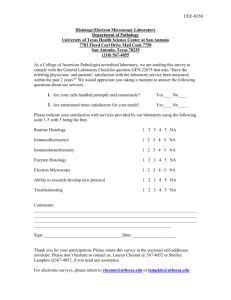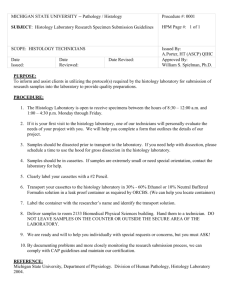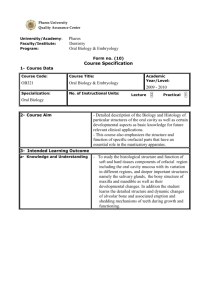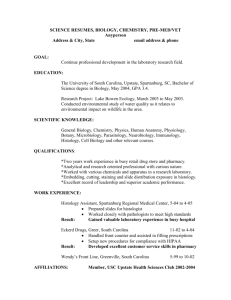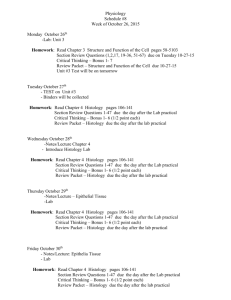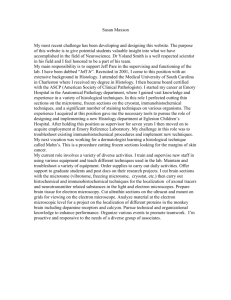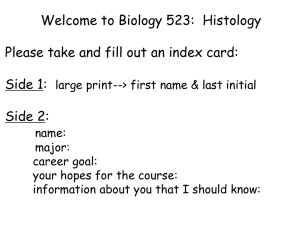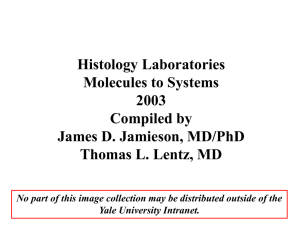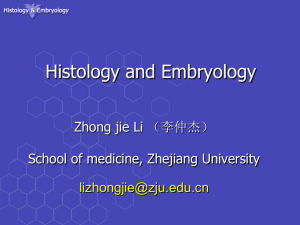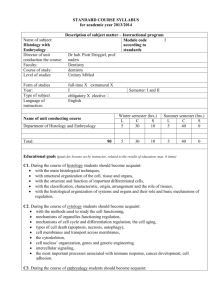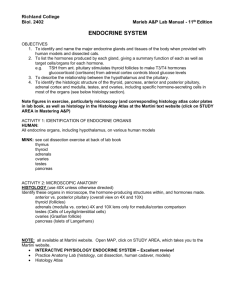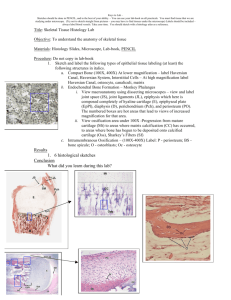University: South Valley University Faculty: Veterinary Med
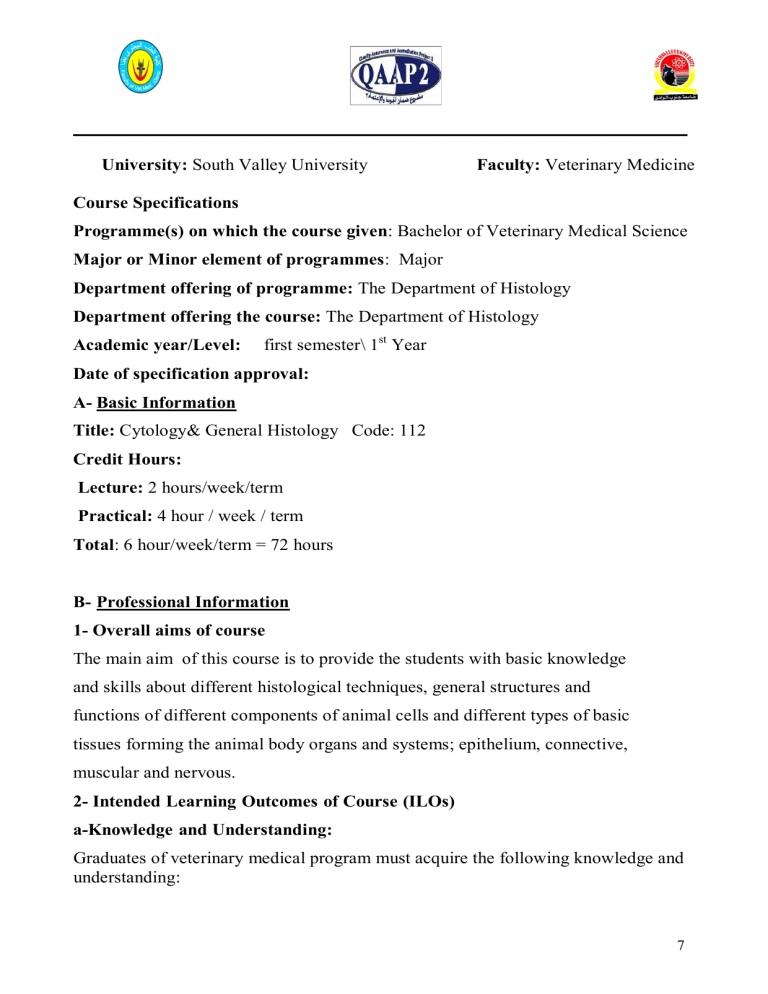
____________________________________________________________________
University: South Valley University Faculty: Veterinary Medicine
Course Specifications
Programme(s) on which the course given : Bachelor of Veterinary Medical Science
Major or Minor element of programmes : Major
Department offering of programme: The Department of Histology
Department offering the course: The Department of Histology
Academic year/Level: first semester\ 1 st
Year
Date of specification approval:
ABasic Information
Title: Cytology& General Histology Code: 112
Credit Hours:
Lecture: 2 hours/week/term
Practical: 4 hour / week / term
Total : 6 hour/week/term = 72 hours
BProfessional Information
1- Overall aims of course
The main aim of this course is to provide the students with basic knowledge and skills about different histological techniques, general structures and functions of different components of animal cells and different types of basic tissues forming the animal body organs and systems; epithelium, connective, muscular and nervous.
2- Intended Learning Outcomes of Course (ILOs) a-Knowledge and Understanding:
Graduates of veterinary medical program must acquire the following knowledge and understanding:
7
a1- Know basics for different cell and tissue studying methods especially light and electron microscopy. a2- Describe the structures and functions of different cell parts. a3- Discuss in details the general characteristic features of each type of the basic 4 tissues, list their functions and explain their subtypes, and know their specific locations in animal organs and systems. b- Intellectual skills
Graduates must have the ability to: b1-identify commonly used histological instruments especially microtomes and microscopes. b2- identify different parts of cells either under a microscope or in a photograph. b3- recognize and differentiate different types of normal cells and tissues and correlate their structures to functions. c- Professional and practical skill
Graduates must be attain the capacity to: c1- use some histological instruments especially microtomes and microscopes . c2- process a sample for light microscopy, use the microscope efficiently and examine a glass slide with different magnifications c3- Draw a labeled diagrams for each cell and tissue type. d- General and transferable skills
Graduates must have the ability to: d1- Conduct a minor scientific research. .
d2- be a part in scientific discussion and present prestigiously..
d3- improve their computer skills.
3- Contents :
Topic
Histological techniques
Cytology
No. of hours Lecture
6
12
2
4
Tutorial/Practical
4
8
8
Epithelial tissue
Connective tissue
12
6 proper
Cartilage and bone
Blood
Muscular tissue
Nervous tissue
Revision
MCQ- exam
4- Teaching and Learning Methods
4.1- Lectures.
4.2- Discussion.
6
6
6
6
12
1
4
2
2
2
2
2
4
-
8
4
4
4
4
4
8
-
4.3- Practical classes
5- Student Assessment Methods
5.1-. Written and MCQ exams to assess mostly knowledge and understanding.
5.2- Oral exam to assess knowledge information and intellectual skills mainly.
5.3-. Practical exam to assess professional and practical skills.
5.4- Activities depending upon internet-based search about specific topic to examine general and transferable skills.
Assessment Schedule
Assessment 1: Mid term MCQ exam Week 13
Assessment 2: Practical exam Week 13
Assessment 3: Final- Written exam Week 16
Assessment 4: Oral term exam Week 16
Weighting of Assessments
Mid term exam 20%
Final- term exam 50%
Oral term exam 10%
9
Practical exam
Other types of assessment
15 %
5%
Total 100%
6- List of References
6.1- Course Notes
Veterinary Histology & Cytology (Part I): Department of
Anatomy and Histology, Faculty of Veterinary Medicine, Assiut
University.
Ghallab, A. (2004). Introduction to functional and clinical histology, text and atls- part I. Giza, Elmelegy press.
Ahmed YA, notes on histology (personal notes).
6.2- Essential Books (Text Books)
Paulsen, D. (1997). Basic Histology; Examination and Board review. Norwalk, CT, APPLETON & LANGE.
Gartner, L. and J. Hiat (2006). Color textbook of Histology,
Saunders.
Young, B. and Heath, J. (2000). Wheather's Functional Histology, a text and colour atlas. Sydney, CHURCHILL LIVINGSTONE.
6.3 Recommended Books.
6.4 Periodicals, Web Site,…etc
Periodicals: o Journal of Histology. o Journal of Electron Microscopy o Cell
10
Web sites: http://education.vetmed.vt.edu/Curriculum/VM8054/VM8054HP.htm http://www.ivis.org/home.asp http://www.svu.edu.eg/arabic/links/camps/qena/veter_medicine/index
.htm http://www.lab.anhb.uwa.edu.au/mb140/
16-
17-
18-
19-
20-
21-
22-
5-
6-
7-
8-
9-
10-
11-
12-
13-
14-
15-
7- Facilities Required for Teaching and Learning
No.
1- Paraffin microtome
Hot air ovens
Instrument
2-
3-
4-
Digital pH meter
Digital balance
Incubator
Student microscopes
Chemicals
Image analysis system
Transmission electron microscope
Scanning electron microscope
Slide projector
Overhead projector
Tissue processor
Cryostat
Deep freezer
Fridges
Ultra tome
Water bath
Jars and bottles
Shaker
Laminar flow
Centrifuge
Course Coordinator : Dr. Yasser Abdel Galil Ahmed Ali
Date:
11
